Bathroom screens: types, how to choose the right one, which one is better and why
Wanting to reduce the cost of producing plumbing fixtures, the manufacturer produces products with a minimum set of devices and accessories, giving us the opportunity to independently decide whether or not to buy screens for the bathroom.
And not everyone wants to buy plastic panels if there are other materials. How to choose the most suitable option, what should you pay attention to when purchasing or placing an individual order?
The content of the article:
Configuration and design features of products
The design of the screen, which is installed under the bathtub, consists of a set or just one front panel and a frame, which is made in the form of two guides or a frame. The decorative screen can be straight or angular, solid or consist of several elements made in the form of hinged or sliding doors.
The main difference between the screen and the panel is that the latter is made primarily from plastic by the bath manufacturers themselves. It clearly matches the shape and size of the bowl of the same model. By choosing the right panel, you can be sure that the dimensions will fit perfectly.
The location of the screen may also differ: strictly vertical, inclined at an angle, with a recess for the feet. Both options have their pros and cons.The first will not allow you to get close to the bathtub and will make its maintenance inconvenient; the second will worsen the appearance and create a sharp angle between the floor and the screen, which will be difficult to clean with a mop.

The sizes of finished screens that go on sale have standard values. Front panels are available in widths: 75 cm, 85 cm, 90 cm, 102 cm, 120 cm. Front panels can be from 130 to 210 cm in size. Their height is from 40 to 60 cm. If none of the options is suitable, You can order a product with the required parameters.
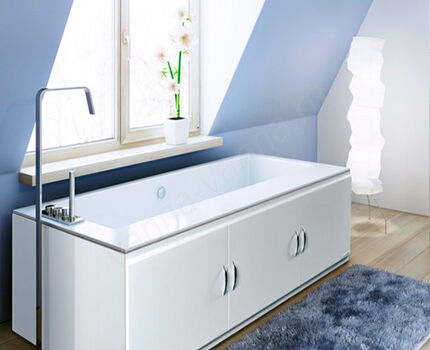
The screens are equipped with two or three legs, the bottom of which is equipped with plastic to prevent slipping. They are adjustable, so choosing the required height is easy, especially considering that the height of the bowls is mostly standard. With the help of the legs, the screen is installed against the background, protecting the space under the bathtub from moisture.
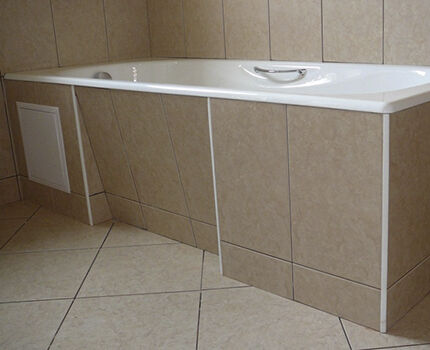
When choosing a product, it is also important to evaluate the quality of the fittings used. Handles, frame and guides must be made of material that is not susceptible to corrosion. Otherwise, it may happen that the screen will serve for many years, and the peeling coating will “please” you for the same amount of time.
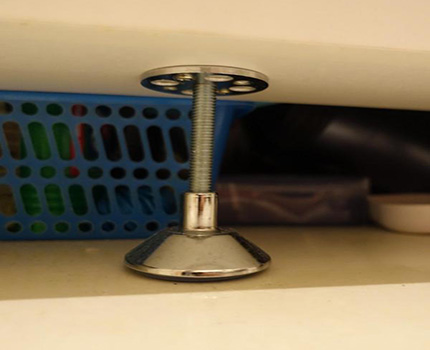
What material to choose a bath panel from?
Since the main purpose of the screen, in addition to decorative, is to protect the space under the bathtub from moisture, the materials for the manufacture of products must be water-repellent and do not deteriorate when exposed to steam and water.
Almost all materials that are used in the manufacture of bathtub screens have this property, but there are also those whose use is puzzling.
MDF screen: aesthetics or practicality?
A screen with an MDF panel is most often made in the form of hinged or sliding doors. A shelf can be equipped inside. This decorative panel looks much more beautiful than the plastic type, and besides, when ordering MDF furniture for the bathroom, you have the opportunity to choose a product in the same style and color scheme.

The main disadvantage is its poor resistance to the effects of a humid environment. Despite the fact that moisture-resistant MDF is used in production, in case of frequent contact with water, the material swells and the outer coating peels off.
The frame, which is made of moisture-resistant chipboard or wooden blocks, is also afraid of moisture. Negative reviews from buyers of MDF panels claim that problems begin to appear within six months after installation. Another drawback is that the material is difficult to cut.
If the finished product does not fit in size and needs adjustment, then this will be problematic.The fact is that MDF needs to be cut on powerful equipment used in woodworking with a large number of revolutions, otherwise the cut edges will turn out torn. A regular hacksaw or electric jigsaw can greatly ruin the appearance of the product.

Aluminum bath screen: reliability and variety
Aluminum screens are primarily a frame made of aluminum profile. Plexiglas, MDF panels, and PVC can be used as a decorative panel. The range of products with different designs is quite high, you can choose for every taste.
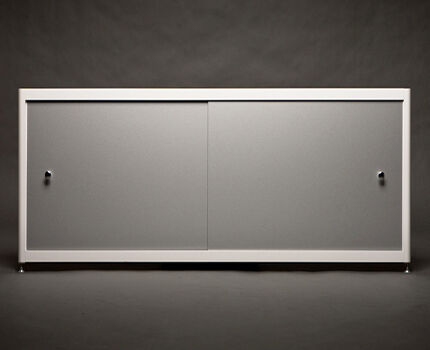
The main properties of the screen that suggest themselves, even without reading the manufacturer’s specifications, are reliability and durability.
The aluminum frame and guides do not corrode, the products tolerate mechanical loads well and do not deform when exposed to moisture. Not the lowest cost is fully compensated due to the durability of the material.
Plastic decorative panels for bathtubs: pros and cons
The screen is a panel made of cellular plastic, which is installed in a frame body made of PVC or aluminum profile. The cheapest and most common models are white. They also produce screens covered with self-adhesive film in various colors, including those with 3D patterns.
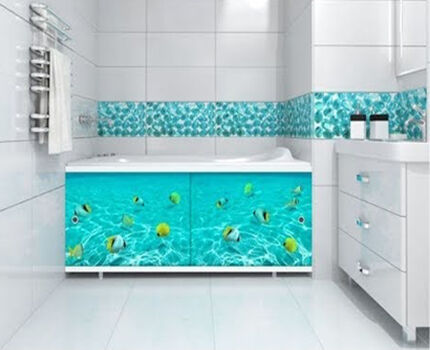
The popularity of plastic screens can be explained by a number of advantages:
- ease of installation, adjustment to the required size;
- low cost compared to panels made from other materials;
- the greatest variety of sizes, shapes, designs, colors and patterns;
- insensitivity to high humidity, direct and prolonged contact with water;
- long service life - depending on the quality of production, they are used from 10 to 30 years.
Judging by user reviews, plastic screens are not a very durable design, and some models can be called fragile. Therefore, they require careful handling and should be protected from shock. Do not use abrasive materials to clean the panels.
Glass screen: longevity despite apparent fragility
Tempered glass is used to make glass screens for bathtubs. The material has all the necessary qualities for use in the bathroom: it is moisture-resistant, strong, durable, easy to clean and, unlike plastic, is not susceptible to scratches or plaque formation to the same extent.
Glass panels can be solid, with sliding, opening or tilting doors. The frame is made of aluminum alloy, which is coated with powder enamel.
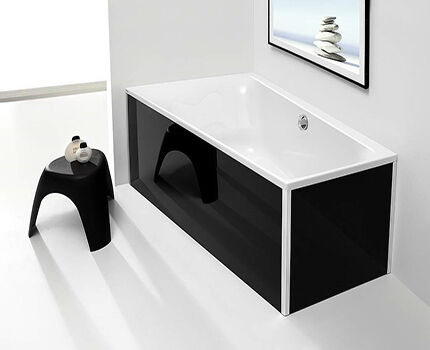
For baths they also produce mirror screens, which look great in the interior and visually expand the space.The disadvantage of such products is their high cost and fragility.
In addition, mirror panels are more difficult to maintain, since fingerprints and water splashes are clearly visible on the surface. To maintain cleanliness, they must be wiped constantly.
Tiles and mosaics - traditional quality
During repairs, the choice of protective and decorative cladding makes it possible to focus on the already traditional finishing with mosaics or ceramic tiles. This solution will allow you to maintain a single style, and homemade screen will serve as good protection against moisture and will last until the next major overhaul.
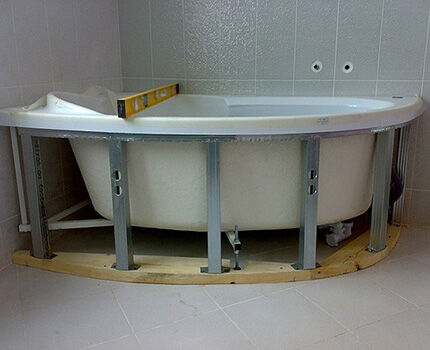
Ceramic cladding, compared to other options, is more expensive, especially if the tiles used in the bathroom are not cheap, and installation will require more time and effort. But the result will be pleasing to the eye, and you can forget about screen maintenance or repair for a long time.
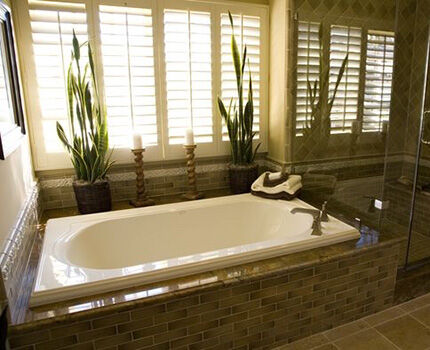
The basis for the tiles can be a surface made of moisture-resistant plasterboard or tongue-and-groove slabs, or brickwork. For an oval or semicircular bowl, it is easier to use polystyrene foam boards. The frame is installed from a galvanized metal profile. Less commonly, frame tile screen constructed from wooden blocks.
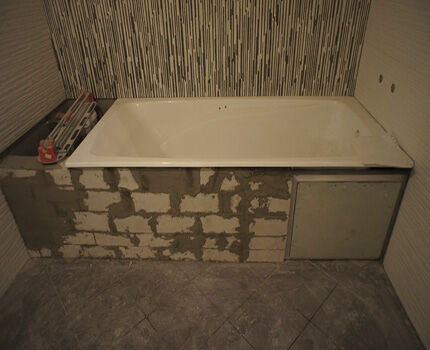
The main requirement for the material is resistance to moisture, strength, it should not deform under the weight of the cladding. In some cases, chipboard is also used, but its use in a bathroom is extremely undesirable, since it is afraid of contact with water.
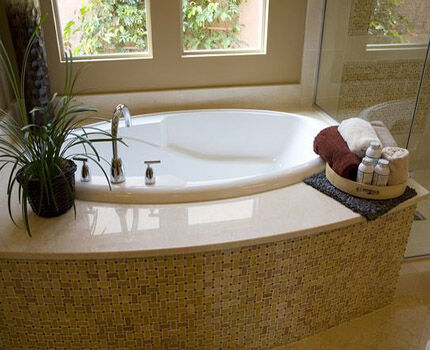
The independently developed design allows you to competently and conveniently organize the space covered by a decorative protective panel. How to make a screen with shelves and departments, find out their recommended articles.
Natural materials for bath design
The desire to increasingly use natural materials in interior design has become the impetus for the creation of wood screens. It would seem that this material certainly cannot be used where it will often come into contact with water.
But modern production and processing technologies help to do the impossible. New wood protection products allow you to use natural material outdoors, in the open air and, of course, in the bathroom.

Less often you can find finishing with natural or artificial stone.This design option is an excellent alternative to tiles. And although the cost is quite high, natural or imitating materials will last a long time and will always be relevant and will not go out of fashion.
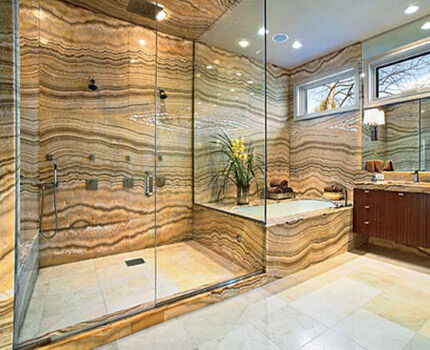
Features of installation of decorative panels
Ready-made screens, provided that all sizes match, are installed fairly quickly. But sometimes the height of the legs is not enough to cover the space under the bowl. Then the standard bolts are replaced with longer ones.
Problems can also arise if the bathtub is not installed strictly horizontally. In this case, it is better to first check the level of installation of the plumbing itself and correct this situation.

A mismatch in product width can also complicate installation. A screen that is larger in width than necessary is reduced by cutting the frame on the sides. But you need to be prepared that not every product can be cut. If the screen is smaller, then the remaining space is covered with a small plasterboard wall.
Despite all the variety of models, sometimes you still have to make the screen yourself. This also happens because the required size or shape may not be available for sale. An incentive to independently build a decorative panel can also be the desire to maintain style, embody an original idea, and make the most of the bathroom space.
It is easier to install the screen yourself if it is a one-piece design. If you want to provide maximum access under the bathtub and use this space for storing things, then it is better to use a screen with doors.
But install sliding screen for bathtub doing it on your own will be more difficult and unlikely to be cheaper. For bathtubs of standard sizes and shapes, it may be better to consider ready-made options.
Conclusions and useful video on the topic
Video #1. What material to choose from for a bathtub panel:
Video #2. Presentation of a finished structure for masking the space under the bathroom:
Video #3. Variety of colors and patterns:
The bath screen is a fairly significant interior detail. Therefore, the aesthetic factor often tips the scales in its favor.
But we should not forget about the practical side and choose a decorative panel for the bath that is not only beautiful, but also reliable, one that will last a long time without losing its appearance or functionality.
Tell us about how you installed the screen to install the plumbing with your own hands. It is possible that your experience will be useful to site visitors. Please write comments in the block below, post photos here and ask questions about the topic of the article.




I bought a regular plastic screen, which I adjusted to the size of the bathtub. The problem was that the bathtub was initially installed at an angle relative to the horizon, so it had to be adjusted manually. Due to the insufficient rigidity of the structure, difficulties constantly arose with moving the panel. Also, the decorative ring, which acts as a handle, flew out very quickly.In the future, I will consider the options proposed here for updating the screen under the bathtub.
For a very long time we did not have a screen installation in our bathroom at all, but this did not affect the aesthetic appearance in any way. Nevertheless, to create a certain style, we purchased plastic decorative panels with a 3D pattern. The design, frankly speaking, turned out to be fragile and we replaced it with an aluminum profile version. It turned out to be an order of magnitude more expensive than plastic, but due to stability this particular option wins.